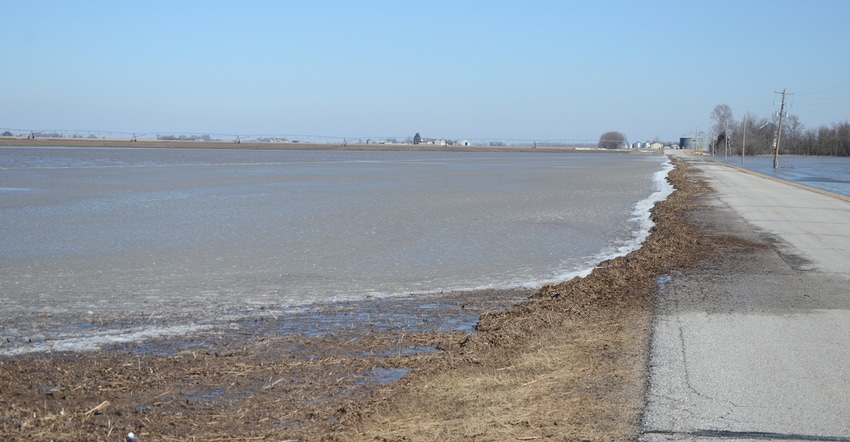April 2, 2019

Where there is significant damage from flooding to cropland, should the rental rate be adjusted for 2019? The answer lies in the characteristics of the individual situation.
How bad is the damage and who is going to fix it?
Work to restore flood-damaged land can be categorized into two distinct types. One is the “hard” work, and the other is the “heavy” work.
The “hard” work probably will not be avoided. This usually includes quite a bit of hand labor and light work with equipment to remove branches, cornstalks, trash debris and other obstacles deposited on the field.
The “heavy” work may not need to be done at all. This work includes heavy equipment such as bulldozers, scrapers or graders to take care of major problems. It might include moving topsoil, removal of sandbars, and fixing holes, gullies and ruts from the flooding.
In both cases, the party primarily responsible for completing this work is the landlord. The landlord bears the responsibility for providing the tenant with the land ready to farm.
Desiring a positive long-term landlord-tenant relationship and knowing the work needs to be done in a timely fashion, most tenants are probably going to provide most — if not all — the “hard” work described above.
When that happens, is it appropriate for the landlord to acknowledge that effort? Most would say yes.
Should rental rates be adjusted?
Crop share. If the land lease arrangement is a conventional crop share, the rental rate may not need to be adjusted. Since the crop share lease arrangement shares production risk between the landlord and tenant if the production varies, the amount received from a share varies based on production.
Crop insurance policies contain preventative plant provisions that could lead to an insurance payment, even though nothing was planted. This will only apply to those with an insurance policy, and payment size, if any, depends upon the rules contained in the preventative plant provisions.
Nebraska Extension encourages those with crop insurance policies to contact their agent about preventative planting rules.
Cash rent. For cash rents, is it appropriate for the landlord to receive a full cash rent payment for 2019 if the land has flood damage? Because of the language in the lease contract, full payment likely will be expected.
However, is that equitable to both parties? Good landlord and tenant communications will be key to deciding equitable payment for 2019.
Begin that conversation now instead of waiting until the end of the production year. Waiting likely will result in a hardship with at least one of the parties. The language contained in the lease needs to be examined. If the lease does not specifically address weather-related events before planting, the amount paid might vary.
Under contractual law, if an event renders the property unusable for the entire growing season, the tenant may have a case for vacating the premise and not making any lease payments for 2019. Seeking release from a property under these terms may have a devastating effect on the relationship between the tenant and the landlord (even the neighborhood) in the future.
One suggestion in 2019 is to look at some way to adjust cash rent based on actual productivity. Another possibility is to use some measure of total revenue on a per acre basis or setting up some type of flexible cash rent that considers the date of planting, damage to topsoil, sand deposits and other aspects that might affect yields.
Check with your local agricultural economics Extension educator for ideas to accomplish this.
Do you have crop insurance?
The other issue with cash rental rates relates to the holder of the crop insurance policy, which is the tenant. The tenant may consider assisting the landlord in the “hard” or “heavy” work by contributing preventative planting payments to clean up flood-damaged farmland.
For crop share rents, both the landlord and tenant could have crop insurance, which likely will include a prevented planting coverage. For either type of rental arrangement, it's important to maintain good communications with your insurance agent.
In addition, good communications between landlord and tenant on issues such as this will go a long way toward an amicable resolution.
Also, be sure to visit with USDA's Farm Service Agency to understand any implications on changes to the crop lease agreement.
For government help, be sure to document
There will be situations where the cost of doing both the “heavy” and the “hard” work can be documented and submitted to the Farm Service Agency for Emergency Conservation Program payments.
The key is to provide adequate documentation, including pictures (before and after), that tracks equipment used, supplies and labor.
If you are modifying your rental agreement for 2019, get it in writing. Stress may be high, and you will want to make sure both parties are fully aware of what they are agreeing to.
This may be the year that both parties need to share the pain of the March flooding. Good communications between landlord and tenant is probably the only sure way both parties are satisfied with the results of the lease.
If you have questions on this issue, Nebraska Extension educators working in agricultural economics can help:
Austin Duerfeldt, Southeast District, 402-873-3166; [email protected]
Jim Jansen, Northeast District, 402-261-7572; [email protected]
Robert Tigner, West Central District, 308-696-6734; [email protected]
Jessica Groskopf, Panhandle District, 308-632-1247; [email protected]
Allan Vyhnalek, Department of Agricultural Economics, 402-472-1771; [email protected]
Source: Nebraska Extension, which is solely responsible for the information provided and is wholly owned by the source. Informa Business Media and all its subsidiaries are not responsible for any of the content contained in this information asset.
You May Also Like




